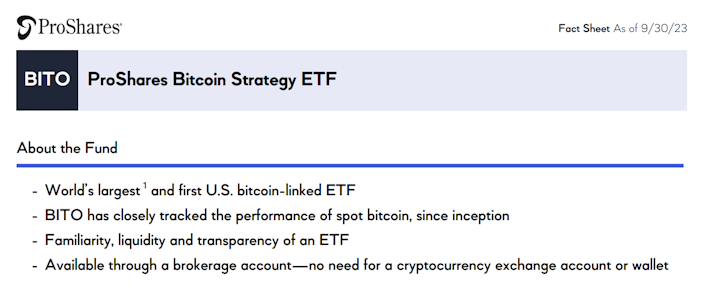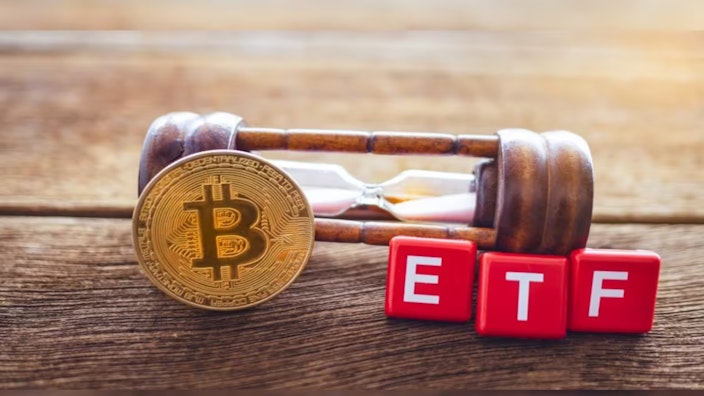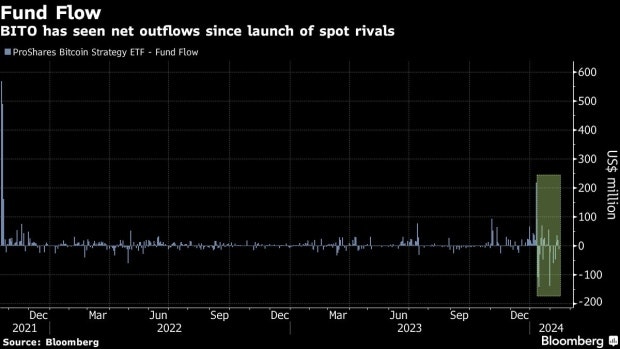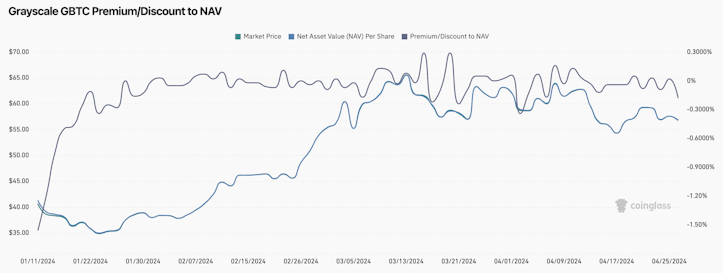BITO vs. GBTC Compared: Which is Best in 2024?
BITO vs. GBTC… Which is best in 2024? Neither. Learn why!

Two major players have consistently captured the attention of institutional and other Bitcoin investors: BITO (ProShares Bitcoin Strategy ETF) and GBTC (Grayscale Bitcoin Trust).
This article delves into a comprehensive comparison of BITO and GBTC, aiming to provide clear insights for both seasoned and novice investors navigating the Bitcoin landscape.
We’ll explore their distinct characteristics, benefits, performance, fees and drawbacks, focusing on how spot Bitcoin ETFs fit into the broader context of Bitcoin investment strategies.
TL; DR: BITO, the ProShares Bitcoin Strategy ETF, offers a taste of Bitcoin through futures contracts.
ProShares Bitcoin Strategy ETF (BITO)
The ProShares Bitcoin Strategy ETF primarily allocates its investments to Bitcoin futures contracts instead of directly investing in Bitcoin. It stands as the largest and most frequently traded Bitcoin ETF globally, boasting an AUM of $2.1 billion.
With an annual fee of 95 basis points, it sees an average daily trading volume of 20 million shares, highlighting its leading role in the rally as Bitcoin surpasses the $52,000 mark.
Since the introduction of spot rivals, BITO has experienced a net outflow of $254 million, according to data gathered by Bloomberg. Until December, BITO had accounted for 92% of the trading volume among U.S. Bitcoin-linked ETFs.
Grayscale Bitcoin Trust (GBTC)
The Grayscale Bitcoin Trust, the world’s largest Bitcoin ETF, offers investors the opportunity to invest in Bitcoin as a security, circumventing the difficulties associated with the direct purchase, storage, and safekeeping of Bitcoin.
Through Coinbase Custody, the Trust passively possesses real Bitcoins. With AUM totaling $22.7 billion, it levies a 1.50% annual fee on investors. On average, it experiences a substantial daily trading volume, exceeding 26 million shares.
Despite ALL of GBTC’s competitors lowering their spot Bitcoin ETF fees just before 10 spot Bitcoin ETFs were approved by the SEC — GBTC notably did not.
GBTC remains at 1.5% — the highest of any provider.
But here’s the twist — what if I told you that neither BITO nor GBTC is your best bet?
BITO (ProShares Bitcoin Strategy ETF): An Overview
Key aspects:
Structure: BITO operates as an ETF, trading on stock exchanges and offering intraday liquidity.
Investment Focus: It primarily invests in Bitcoin futures contracts, not directly in Bitcoin.
Fees: BITO charges a management fee, usually lower than GBTC’s fee structure.
Performance: As BITO tracks Bitcoin futures, its performance may not precisely mirror the spot price of Bitcoin. It’s influenced by the futures market dynamics.

Pros
ETF Structure: BITO, being an ETF, offers greater liquidity and is traded on major stock exchanges. This makes it easier to buy and sell during market hours.
Lower Fees: Generally, BITO has a lower fee structure than GBTC, which is more cost-effective for investors.
Regulated Framework: BITO operates within a regulated framework, providing a sense of security for investors wary of the unregulated nature of cryptocurrencies.
Futures-Based Exposure: Offers exposure to Bitcoin futures, which might be more appealing for investors looking to avoid the direct volatility of Bitcoin.
Cons
Indirect Exposure to Bitcoin: As it invests in futures contracts, BITO does not provide direct exposure to the actual price movements of Bitcoin.
Futures Market Risks: Futures contracts can introduce contango and backwardation risks, potentially affecting returns.
Active Management Risk: The Fund is actively managed and its performance reflects the investment decisions that ProShare Advisors makes for the Fund. ProShare Advisors’ judgments about the Fund’s investments may prove to be incorrect.
GBTC (Grayscale Bitcoin Trust): An Overview
GBTC offers investors a traditional investment vehicle to gain exposure to Bitcoin’s price movements without the challenges of buying, storing, and safekeeping Bitcoin directly.
GBTC holds actual Bitcoin as a trust and its shares trade over the counter.
Structure: GBTC is a trust, not an ETF. It trades over the counter (OTC) and doesn’t offer the same liquidity as ETFs like BITO.
Investment Focus: GBTC holds actual Bitcoin, offering more direct exposure to Bitcoin’s price.
Fees: The annual fee for GBTC tends to be higher, accounting for security, storage, and insurance of the held Bitcoins.
Performance: GBTC’s price can deviate significantly from the underlying Bitcoin price, often trading at a premium or discount.

GBTC has experienced net outflows of 310,611 BTC in the 66 trading days since its conversion. That’s a 50.16% reduction in Bitcoin in its fund since January 10.
Pros
Direct Exposure to Bitcoin: GBTC holds actual Bitcoin, directly exposing its price movements.
Simplicity: It’s a straightforward way for investors to gain exposure to Bitcoin without the complexities of managing Bitcoin wallets and keys.
Traditional Investment Vehicle: As a trust, it can be held in certain tax-advantaged accounts, like IRAs.
Cons
Higher Fees: GBTC typically has a higher fee structure due to the costs of securely holding physical Bitcoin. Grayscale has BY FAR the highest Bitcoin ETF fee (1.50%) of any Bitcoin ETF that was approved.
Premiums or Discounts: GBTC can trade at significant premiums or discounts to the underlying Bitcoin price, affecting investment value.
Less Liquidity: Being an OTC product, it lacks the same level of liquidity as a standard ETF.
ETF Conversion Risk: May be forced to “sell & rebuy” Bitcoin as part of the ETF conversion process and may involve capital gains taxes.
Key Comparisons: Fees and Performance
Performance Metrics: BITO performance is tied to the futures market, which can differ from the spot price of Bitcoin. GBTC’s performance is more directly correlated with Bitcoin’s worth but also subject to premiums or discounts based on market demand for the shares.
Fees Impact: BITO has a lower fee structure that is attractive for cost-conscious investors. GBTC’s higher fees cater to the trust’s direct exposure to Bitcoin and additional security measures.
Want to known more about spot Bitcoin ETF fees? Check out our complete overview.
To stay on top of all the daily inflow and outflow changes, check out our new Daily Bitcoin ETF Show, hosted by Dante Cook.
Fee: 1.5%
BTC Holdings: 288,987 BTC with Coinbase
Fee: 0.25% for the first 6 months or $5 billion
BTC Holdings: 275,991 BTC with Coinbase
Fee: 0.25% (0% fees until July 31, 2024)
BTC Holdings: 156,780 BTC in self-custody
Fee: 0.21% (0% fees for the first 6 months or $1 billion)
BTC Holdings: 47,296 BTC with Coinbase
Fee: 0.20% (0% fees for the first 6 months or $1 billion)
BTC Holdings: 35,438 BTC with Coinbase
Fee: 0%
BTC Holdings: 9,474 BTC with Gemini
Fee: 0.49% (0% fees for the first 3 months)
BTC Holdings: 8,463 BTC with Coinbase
Fee: 0.25% (0% fees for the first 6 months or $5 billion)
BTC Holdings: 6,877 BTC with Coinbase
Fee: 0.19%
BTC Holdings: 6,147 BTC with Coinbase
Fee: 0.30% (0% fees for the first 6 months or $1 billion)
BTC Holdings: 1,163 BTC with Coinbase
Fee: 0.90% (converted from futures ETF to Spot ETF on 03/27/24)
BTC Holdings: 178 BTC with BitGo
Fee information is updated daily. For the latest updates, click here.
Discounted Fees
Some ETFs may offer discounted fees for a limited period, so investors should know the terms.
Trustworthy Companies
To ensure security and reliability, choose an ETF backed by a trusted company with substantial assets under management (AUM).
Want to known more about spot Bitcoin ETF fees? Check out our complete overview.
BITO vs GBTC | Performance and Concerns
BITO is intricately linked to its futures contracts, which can lead to what is known as 'roll decay.'
WTH is roll decay?
Roll decay is a phenomenon typically associated with futures-based ETFs like BITO.
BITO doesn’t invest directly in Bitcoin — it holds futures contracts.
Futures contracts are agreements to buy or sell the asset at a predetermined future date and price.
They have expiration dates, and to maintain exposure to Bitcoin.
BITO must periodically 'roll' its futures contracts to later-dated ones.
The issue of roll decay arises particularly in a market situation known as 'contango.'
GBTC provides a more direct way to gain exposure to Bitcoin — it holds real Bitcoin. However, its structure as a trust, not an ETF, has led to significant variances in its trading price compared to the actual value of the Bitcoin it holds.
GBTC initially traded at a premium, but has more recently seen a shift to trading at a discount, raising concerns about its effectiveness as an investment vehicle for Bitcoin exposure.
The GBTC Discount
The discount on the Grayscale Bitcoin Trust (GBTC) has been a significant factor in its performance evaluation.
This discount means that GBTC shares trade at a lower price than the actual Bitcoin value they represent.
Over time, the discount has not only persisted but widened, raising concerns about its attractiveness to investors.
Many investors prefer more accurately priced exposure to Bitcoin, which GBTC currently struggles to provide.
BITO’s Growing Appeal
In contrast, the ProShares Bitcoin Strategy ETF (BITO) has been gaining appeal.
BITO attracts those seeking an investment product that aligns more closely with traditional ETF structures.
Despite concerns regarding roll decay, BITO offers a unique type of exposure to Bitcoin that might be more familiar and appealing to traditional investors.
BITO’s structure as a futures-based ETF avoids some of the regulatory and structural challenges faced by GBTC.
This structure provides a different type of exposure to Bitcoin, which might be more appealing to those used to traditional ETFs.
Roll decay is a critical concern for BITO investors.
This phenomenon affects futures-based ETFs like BITO, which invest in futures contracts rather than holding the underlying asset directly.
Futures contracts have set expiration dates, requiring a process called 'rolling over, ' where expiring contracts are replaced with new ones.
In a market condition known as contango, future contracts are priced higher than the current spot price of the asset.
This can lead to losses for BITO, as the ETF might sell futures contracts at a lower price and buy new contracts at a higher price, resulting in roll decay.
Unlike GBTC, BITO’s volatility is influenced by factors inherent in the futures market.
GBTC’s volatility is tied directly to the price of Bitcoin, whereas BITO’s is affected by the futures contracts it holds and the associated roll decay.
The Grayscale Bitcoin Trust (GBTC) is structured as a trust that holds Bitcoin, allowing investors to gain exposure to Bitcoin’s price movements without directly owning Bitcoin.
One significant risk factor is the GBTC discount or premium to its net asset value (NAV).
The discount or premium to NAV measures the percentage difference between the trading price of an ETF or closed-end fund (CEF) and its NAV.
This figure is crucial for assessing how much a security’s market price deviates from its actual value.
It is particularly significant for closed-end funds, as they do not create new shares after their initial public offering, leading to potential significant divergence between market price and asset value.
Unlike traditional ETFs, GBTC shares often do not trade in perfect alignment with the NAV of the Bitcoin they hold.
This discrepancy has led to GBTC trading at either a premium or a discount to its NAV.
GBTC has predominantly traded at a discount, meaning its market price is lower than the value of the Bitcoin per share it represents.
This discount has been notably unpredictable, fluctuating based on various factors such as market sentiment, investor demand, and regulatory developments.
For more detailed information on GBTC and its pricing dynamics, visit Swan Bitcoin’s analysis.
Increased Exposure: Investors in GBTC face the dual risk of Bitcoin’s price fluctuations and the variability of the discount.
Potential Underperformance: Even if Bitcoin’s price rises, a widening discount can lead to underperformance relative to direct Bitcoin investments.
Complex Valuation: The fluctuating discount complicates the valuation of GBTC as an investment.
Timing Difficulties: Determining the right entry and exit points becomes more challenging when the discount level is volatile and seemingly detached from Bitcoin’s market performance.
Sentiment Barometer: The discount level can act as a barometer for broader market sentiment towards Bitcoin.
Confidence Indicator: A widening discount might reflect decreasing confidence or increasing regulatory concerns, while a narrowing discount could signal growing investor optimism.
Buying Opportunities: A deep discount might present a strategic buying opportunity, assuming it will eventually narrow.
Selling Signals: Conversely, a small discount or a premium might indicate a good time to sell.
For more insights into GBTC’s pricing dynamics and investment risks, visit Grayscale Bitcoin Trust.
Unlike a direct Bitcoin investment or a spot Bitcoin ETF, BITO invests in futures contracts traded on the Chicago Mercantile Exchange (CME).
This approach provides exposure to Bitcoin’s price movements without the challenges of holding the actual cryptocurrency, such as storage and security concerns.
Roll Decay: The primary concern with BITO’s futures-based structure is 'roll decay.'
Roll Over Process: Roll decay occurs when the fund rolls over expiring futures contracts to later-dated ones, often at a higher price in a contango market condition.
Performance Lag: This can cause the ETF’s performance to lag behind the actual spot price of Bitcoin, especially in prolonged contango market conditions.
Futures Market Liquidity: Liquidity in the futures market can impact BITO’s ability to closely track Bitcoin’s price.
Rollover Costs: Varying costs associated with rolling over contracts can affect performance.
Market Divergence: Occasional divergence between futures and spot prices can lead to disparities in performance.
Understanding these factors can help investors make informed decisions about investing in BITO and anticipate how its structure might impact performance. For more information, visit CME Group.
BITO and GBTC cater to different investor needs and risk appetites…
BITO is preferable for those seeking an ETF structure with lower fees and indirect exposure to Bitcoin via futures, while GBTC suits investors seeking direct exposure to Bitcoin’s price movements despite potentially higher fees and the risk of trading at premiums or discounts.
Making the Decision: What to Consider!
Investment Goals: Consider whether you want direct exposure to Bitcoin’s price (GBTC) or prefer the derivatives market (BITO).
Risk Tolerance: GBTC’s direct exposure to Bitcoin’s price can be more volatile. BITO’s exposure to futures may involve different types of market risks.
Cost Sensitivity: BITO’s lower fees might be more appealing if fees are a significant consideration.
Liquidity Needs: BITO’s ETF structure provides easier entry and exit points if you prioritize liquidity.
Account Type: If you’re investing through a particular account type (like a Swan Bitcoin IRA account), check which product is compatible.
Every Monday — Friday, Dante Cook releases a Bitcoin Daily Show for the latest Bitcoin ETF news. Check out his most recent episode below…
With all the complexities and downsides, is there a great alternative to BITO and GBTC?
YES!
Don’t settle for mere exposure through a financial product like BITO or GBTC!
Whether you invest through Swan’s IRA product, or just recurring buys — Swan ensures you are in control of your Bitcoin journey and own actual Bitcoin. If you are looking to own real Bitcoin and self custody or invest in a tax-free BTC IRA, Swan is your best choice!

Secure your financial future with real Bitcoin from Swan Bitcoin.
For more information, contact Terrence Yang, Swan Managing Director, at terrence@swan.com or 312.448.8012 (text or call) for details.
Swan is a leading Bitcoin financial services company with more than 120,000 clients and 170 employees, operating globally. Established in 2019, Swan helps individuals and institutions to understand and invest in Bitcoin. The Swan app simplifies Bitcoin purchases with instant and recurring buys. Swan IRA provides a tax-advantaged solution for saving Bitcoin in retirement accounts.
For HNWIs and businesses, Swan Private provides white-glove service for large purchases, treasury solutions, and employee Bitcoin benefits. With Swan Vault, clients can easily custody their own Bitcoin with peace of mind. Financial advisors trust Swan Advisor for client Bitcoin allocations, backed by world-class custody and educational content.
Swan Managed Mining provides clients with fully segregated and dedicated mining operations, catering to their unique requirements, opportunities, and strategic advantages. Swan prides itself on exceptional client service, making Bitcoin accessible to all. For more information, please visit swan.com.
Swan IRA — Real Bitcoin, No Taxes*
Hold your IRA with the most trusted name in Bitcoin.
Drew, a class of 2013 Bitcoiner, is a Research Analyst for Swan Bitcoin.
He has worked in institutional VC/PE, FinTech, and DLT consulting for over six years. He also brings over twelve years of experience working with national nonprofits and start-ups in education and software development in several leadership roles.
More from Swan Signal Blog
Thoughts on Bitcoin from the Swan team and friends.


Epoch Five — Big League Bitcoin

By Tomer Strolight
Block 840,000 has come and gone. With it, came Bitcoin’s fourth halving, cutting the issuance of new coins to 3.125 per block. Welcome to Epoch V. What awaits us?


An Open Letter to Ann Barnhardt
By Arman the Parman
I decided to write a letter, then made it an open letter, to Ann Barnhardt.


Best Bitcoin ETF Fees: Lowest to Highest (May 2024)

By Matt Ruby
In this guide, we analyze and present the top 10 Bitcoin ETFs with the lowest fees for cost-effective investing.




